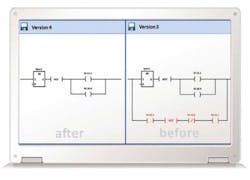Often considered more relevant to IT than operations, version control is just as critical for automation because these systems rely on software and computing technologies as much as enterprise systems do. Essentially, version control for industrial control system applications is an automated process of monitoring, tracking, comparing and backing up changes made to IEC 61131 programs.
Tracking these changes is important because modifications to controllers can lead to plant downtime if programming errors or conflicts arise. Version control helps avoid such conflicts and tracks all changes so that, in case such an error is created, it can more easily be traced back and corrected.
Speaking recently with Silke Glasstetter of Auvesy, a supplier of version control and data management software for automated production applications, she noted that many production managers and employees remain skeptical about version control or data management systems and prefer to rely on older, manual approaches to the process. The problem with this approach, says Glasstetter, is that “the number of editors and devices will steadily increase over time, resulting in more data and a greater potential for error,” especially in light of the adoption of Industry 4.0 and Industrial Internet of Things (IIot) initiatives, as well as manufacturing digitalization in general.
To help clarify the misunderstandings surrounding version control for operations systems, Glasstetter highlighted four common myths she often encounters across industry:
1. Version control is unnecessary. Glasstetter says that most people holding this view maintain that their production facility has not used version control before and has not experienced any problems. But without “modern version control and synchronized upload, download and comparison processes, you can never be sure that the software version controlling your facility matches your most recently shared version,” she says.
2. A homogeneous automation environment is required. This line of reasoning relies on use of the version management capabilities included with a controller. The problem here is that “these solutions only support the manufacturer‘s own devices and are therefore only really useful in homogeneous production facilities,” says Glasstetter.
As we all know, homogenous production environments are the real unicorns of industry.
“The advantage of a future-proof version control system is that you are not dependent on a single manufacturer,” she says. “Plus, version control systems not only support the most common automation systems, but also regularly adapt to the latest device versions.”
3. Version control can only be made to work effectively when there are no external suppliers involved. As with the homogenous production environment reason listed above, many people contend that version control cannot support facilities in which external suppliers, such as OEMs and system integrators, play a role in maintaining operations. Glasstetter says that this is not an issue for modern version control systems. She adds that such instances—where external suppliers work with your production systems—create an even greater need for automated version control. “It’s imperative that a version control system be capable of tracking, monitoring, comparing and checking changes made to control devices by system integrators and OEMs,” she says. “Full validation and traceability are only possible if the reasons why changes have been made are documented.”
4. Backup and version control are the same. A common misconception Glasstetter encounters is the belief that version control and system backups effectively do the same thing. “They are two different tools that work best when used together and ensure that the relevant data is always available when needed,” she says. “On their own, neither centralized backups nor version control can ensure 100 percent security for consistent data. The only way to find out whether the centrally stored projects actually match the productive programs is through the regular, automated comparison of software versions. This way you can track changes and analyze them accordingly.”
Glasstetter added that, in the case of disaster recovery, you will need a restorable backup of the most recent version of your operations’ data. “This means that symbols and comments must also be uploaded,” she says. “You should therefore consider the type and quality of data backups carried out by an automated data management system so that you always have a restorable backup to maximize plant and data availability.”
Leaders relevant to this article:


